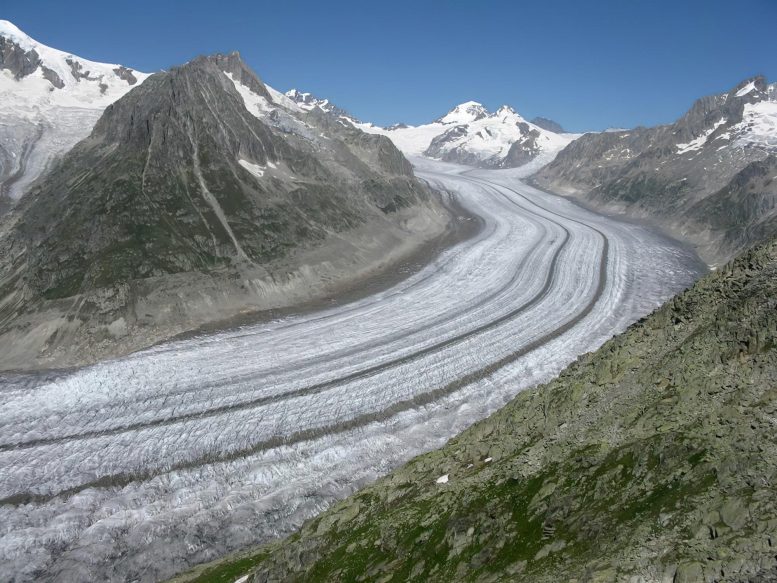
A study by the University of Lausanne and partners predicts a 34% loss of snow in the European Alps by 2050 if global warming stops now, and up to 65% if current trends continue, and uses advanced AI models to make more immediate predictions. Aletsch Glacier in Switzerland in 2009. Credit: UNIL – Guillaume Jouvet
Even if global warming were to stop completely, the amount of snow in the European Alps is predicted to decrease by 34% by 2050. If the pattern seen over the past two decades continues, ice loss could approach nearly half of its current rate. According to a recent international study led by scientists from the University of Lausanne (UNIL, Switzerland).
By 2050, 26 years from now, even if global warming stopped completely immediately, we would lose at least 34% of the snow in the European Alps. This is the prediction of a new computer model developed by scientists from the Faculty of Geosciences and Environment of the University of Lausanne (UNIL), in collaboration with the University of Grenoble, ETHZ and the University of Zurich.
In this scenario, created using machine learning algorithms and climate data, warming stops by 2022, but glaciers continue to suffer losses due to inertia in the climate-glacier system. As greenhouse gas emissions continue to rise globally, these highly optimistic projections are far from a realistic future scenario.
In fact, more than half of the ice volume disappears
Another realistic prediction from the study is that almost half (46%) of the Alps' ice volume will actually disappear by 2050 if the melting trend of the past 20 years continues without drastic changes or measures. If we extrapolate the data from the last ten years alone, it rises to 65%.
2050: The Future
Unlike traditional models that project estimates for the end of the century, the new study, published in Geophysical Research Letters, considers a shorter time frame, which makes it easier to see relevance in our own lifetimes and thus inspire action. How old will our children be in 2050? Will there still be snow in 2038 when Switzerland hosts the Olympics? These estimates are critical because the disappearance of kilometers of ice can have significant consequences for populations, infrastructure, and water availability.
„The data used to create the scenarios stopped in 2022, followed by an exceptionally warm summer. So, the situation could be even worse than we projected,” says Samuel Cook, a researcher at UNIL and first author of the study.
Artificial intelligence improves models
Simulations were carried out using artificial intelligence algorithms. The scientists used deep learning methods to train their model to understand physical concepts and fed real climate and glacier data. „Machine learning is revolutionizing the integration of complex data into our models. This essential step, previously notoriously complex and computationally expensive, is now becoming more precise and efficient,” explains Guillaume Jewett, Professor. at FGSE and co-author of the study.
Reference: Samuel J. „Snow loss in the European Alps up to 2050 using a deep-learning-aided 3D ice-flow model with data assimilation” by Cooke, Guillaume Jewett, Romain Millon, Antoine Rabatel, Harry Zecollari, and Inant, Inant, Inantsa 01, December 2023. Geophysical Research Letters.
DOI: 10.1029/2023GL105029

„Oddany rozwiązywacz problemów. Przyjazny hipsterom praktykant bekonu. Miłośnik kawy. Nieuleczalny introwertyk. Student.
